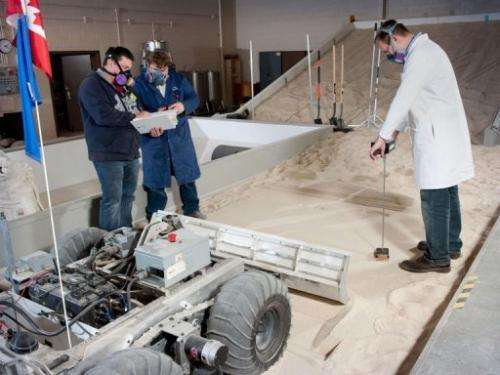Miners shoot for the stars in tech race

A self-sustaining mechanised colony that mines and exports resources from the Moon could be a reality within a generation, helping to meet demand for materials key to innovation on Earth.
That was the view of a recent gathering in Sydney aimed at bringing together some of the top minds in space exploration with firms hoping to cash in on the final frontier of mining: astronomical bodies.
Australia does not have a space agency, but it is home to some of the world's largest mining companies and at the edge of technological advances in the industry, making it a natural fit for what was billed as the world's first Off-Earth Mining Forum.
"There's nothing really science-fiction about any of this," explained Andrew Dempster, from the Australian Centre for Space Engineering Research.
"It's about joining the dots, and I think we've got to the point where people are saying 'yeah, we can do this'".
In some ways the trail has been forged; man has landed six times on the Moon and is in the process of demonstrating that drilling—albeit in small quantities—is possible on Mars with NASA's rovers.
Talks at last month's two-day conference ranged across a breadth of topics from mine automation in Australia and Antarctic testing of drills for use on Mars to converting lunar rocks to waterless cement and fuel.
There is real motivation to shoot skyward, according to the researchers; rare earth minerals vital to everything from wind turbines and hybrid cars to cruise missiles and the ubiquitous smartphone are thought to be abundant.
Vast troves of hydrogen that could be used for fuel are also likely, opening the door to ever-further exploration and exploitation.
NASA's Phil Metzger has mapped a business case for space mining showing that a self-sustaining robot mining colony could be established on the Moon in 20 years with as little as 12 metric tonnes of equipment shipped.
Metzger says that within another 30 years, the industrial capacity of space could be a staggering one billion times that of the United States.
"It's getting very exciting in this field, we are becoming very convinced that the technologies are here now so we can access the billion-fold resources of the solar system," Metzger said.
"We don't have a resource problem in this vast system, we have an imagination problem."
Once established on the Moon, Metzger said the space industry could push even further afield, into the asteroid belt and beyond.
"Space commerce is now exploding as visionaries see that this is possible today," he said. "The benefits are almost impossible to imagine."
It's not a venture without challenges; full automation will be required to overcome the tyranny of communicating over vast distances, while energy and even building materials will have to be sourced locally.
Resource giant Rio Tinto is moving towards remote-controlled extraction with its so-called "Mine of the Future" programme—several companies involved in developing its robots and automated truck and rail systems gave presentations to the conference.
But such hefty machines may be inappropriate for space, with the costs for rocketing objects into orbit remaining prohibitive at about $100,000 per kilogram.
This is where the work of NASA and other space agencies comes in, developing and licensing state-of-the-art technologies for their missions and collecting royalties from private firms who repurpose them for commercial ends.
Rene Fradet, deputy director of engineering at NASA's Mars Curiosity Rover project, said he believed science and industry went "hand in hand", rejecting the notion that there was a conflict of interest.
"We're coming at it strictly from the scientific understanding of planets and bodies and so forth, but we're also addressing and solving a lot of issues that the community will have to face," Fradet told AFP.
Fradet offered a detailed insight into the challenges of operating on Mars, where there is 38 percent the gravity of Earth and its atmosphere is less than one percent the thickness, meaning extreme cold and exposure to radiation.
Communication was delayed by an average of 14 minutes.
Practicalities aside, there are also bigger questions at stake, such as who owns the resources of space and how commercial activities there can be governed.
More than 100 countries, including all the major space powers, have ratified the 1967 Outer Space Treaty, which holds signatory nations responsible for activities in space, including those by private firms, but is yet to be tested.
It mandates that the Moon and other celestial bodies be used "exclusively for peaceful purposes" and activities "shall be carried out for the benefit and in the interests of all countries", raising questions of how mining would fit.
"We're talking about things probably 20-30 years from now, but I think it's a good time to engage in these things and say 'ok where do we want to go, what are some of the milestones?" said Fradet.
"I think it's a good thing to start playing out these scenarios to see what makes sense and where the future leads and so forth. That's a big part of the challenge."
(c) 2013 AFP





















